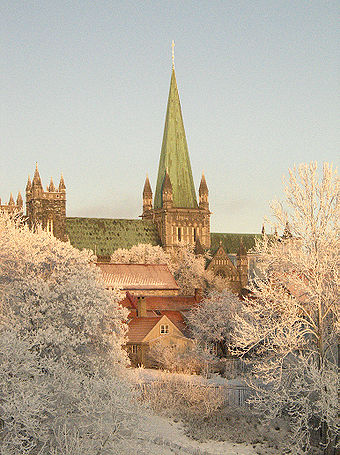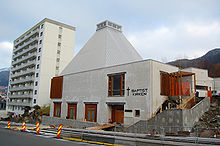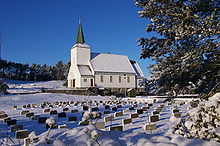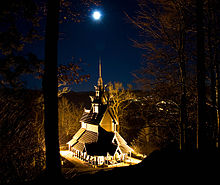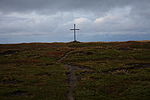- Religion in Norway
-
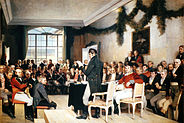
Part of a series on
Norwegians
Culture Architecture · Art · Cinema · Cuisine
Protestant (Evangelical-Lutheran) with 78.9% belonging to the state Evangelical Lutheran Church of Norway.[1] Early Norwegians, like all of the people of Scandinavia, believed in Norse paganism; the Sámi having a shamanistic religion.[2] Due to the efforts of Christian missionaries, Norway was gradually Christianized in a process starting at approximately 1000 AD and which was substantially finished by 1150 AD. Prior to the Reformation, Norwegians were part of the Catholic Church with the conversion to Protestantism occurring in 1536. Islam is now the second largest religion due to recent migration trends although the census shows that there are more people with no religious beliefs.[citation needed] Christianity is growing fast in Norway due to Christian immigration, for example people from Poland, Ethiopia and the Philippines. However, Islam is growing faster as a result of the Church of Norway getting fewer new members. Orthodoxy is the fastest-growing religion in Norway with a rate of 231.1% compared to Islam's 64.3% from 2000 to 2009.[3]According to the most recent Eurobarometer Poll 2005,[4]
- 32% of Norwegian citizens responded that "they believe there is a God"
- 47% answered that "they believe there is some sort of spirit or life force".
- 17% answered that "they do not believe there is any sort of spirit, God, or life force".
- 4% answered that they "do not know".
Phil Zuckerman, an Associate Professor of Sociology at Pitzer College estimates atheism rates in Norway as ranging from 31 to 72%, based on various studies.[5]
Contents
Norse religion
Main article: Norse paganismNorse religion developed from the common mythology of the Germanic people. Scandinavian mythology developed slowly and the relative importance of gods and heroes. Thus, the cult of Odin in Norway probably spread from Western Germany not long before they were written down. Gods shown as minor gods such as Ullr, the fertility god Njord and Heimdall are likely to be older gods in Norway who lost popularity. Other gods (or aesir, as they were called) worth mentioning are the thunder-god Thor and the love-goddess Freya. These gods were most likely originally historical figures that lived during the first period of Germanic civilisation in Scandinavia, and were later idolized as protectors of men and creators of the world by following generations.[citation needed]
Most information about Scandinavian mythology is contained in the old Norse literature including Norwegian literature, the Eddas and later sagas. Other information comes from the Danish historian Saxo Grammaticus with fragments of legends preserved in old inscriptions. Unfortunately, we know relatively little about old religious practices in Norway or elsewhere as most of the knowledge was lost in the gradual Christianisation.
Due to nationalistic movements in the late 18th century, Norwegian scholars found renewed interest for Norse religion, translating many of the myths to Danish (the language in Norway at the time) and tried to use it to create a common Norwegian culture. But Christianity was too deeply rooted in the society to accept such Paganism, and it only resulted in popularized legends. Nowadays, a revival of the Old Norse religion, called Åsatru ("Faith of the Aesir") seeks to reconstruct the pre-Christian faith practiced in the Viking Age.
Sámi religion
Main article: Sami religionThe Sámi followed a shamanistic religion based on nature worship. The Sámi pantheon consisted of four general gods the Mother, the Father, the Son and the Daughter (Radienacca, Radienacce, Radienkiedde and Radienneida). There was also a god of fertility, fire and thunder Horagalles, the sun goddess Beive and the moon goddess Manno as well as the goddess of death Jabemeahkka.
Like many pagan religions, the Sámi saw life as a circular process of life, death and rebirth. The shaman was called a Noaide and the traditions were passed on between families with an ageing Noaide training a relative to take his or her place after he or she dies. While training went on as long as the Noaide lived but the pupil had to prove his or her skills before a group of Noaidi before being eligible to become a fully fledged shaman at the death of his or her mentor.
The Norwegian church undertook a campaign to Christianise the Sámi in the 16th and 17th century with most of the sources being missionaries. While the vast majority of the Sámi in Norway have been Christianised, some of them still follow their traditional faith and some Noaidi are still practising their ancient religion. Sami people are often more religious than Norwegians.
Christianity
Main article: Christianity in NorwayFrom Conversion to Reformation
The conversion of Norway to Christianity began in 1000 AD. The raids on the British isles and on the Frankish kingdoms had brought the Vikings in touch with Christianity. Haakon the Good of Norway who had grown up in England tried to introduce Christianity in the mid-10th century, but had met resistance from pagan leaders and soon abandoned the idea.
Anglo-Saxon missionaries from England and Germany had tried to convert Norwegians to Christianity but only had limited success. However, they succeeded in converting Olaf I of Norway to Christianity. Olaf II of Norway (later Saint Olaf) had more success in his attempts to convert the population with many Norwegians converting in the process, and he is credited with Christianizing Norway.
The Christians in Norway often established churches or other holy sites at places that had previously been sacred under the Norse religion. The spread of conversion can be measured by burial sites as Pagans were buried with grave goods while Christians weren't. Christianity had become well established in Norway by the middle of the 11th century and had become dominant by the middle of the 12th century. Stave churches were built of wood without the use of nails in the 13th century.[6]
From Reformation to 1964
Further information: Reformation in Denmark-Norway and HolsteinThe Norwegians were Catholics until the Danish king Christian III of Denmark ordered Denmark to convert to Lutheranism in 1536 and as Norway was then ruled by Denmark, the Norwegians converted as well. The Danish Church Ordinance was introduced in 1537 and a Norwegian Church Council officially adopted Lutheranism in 1539. Monasteries were dissolved and church property confiscated with the Evangelical Lutheran Church of Norway established and funded by the state. Bishops still adhering to Catholicism were deposed with Olav, Archbishop of Nidaros fleeing the country in 1537 and another bishop dying in prison in 1542. Catholicism held on remote parts of Norway for another couple of decades, although eventually the remaining Catholics converted or fled, to the Netherlands in particular. Many pastors were replaced with Danes and Norwegian clergy being trained at the University of Copenhagen as Norway didn't have a university. The Danish translation of the Bible was used as were Danish catechisms and hymns. The use of Danish in religious ceremonies had a strong influence on the development of the Norwegian language.
The church undertook a program to convert the Sámi in the 16th and 17th century with the program being largely successful. The University of Oslo was established in 1811 allowing priests to train in Norway. The Norwegian Constitution of 1814 did not grant religious freedom as it stated that Jews and Jesuites were denied entrance in Norway. Moreover, adherence to Evangelical Lutheran Christianity was compulsory, and so was church attendance. A ban on lay preaching was lifted in 1842, allowing several free church movements and a strong lay movement being established in the Evangelical Lutheran Church. Three years later, the so-called Dissenter Law came into effect, allowing other Christian congregations to establish in Norway. Atheism became allowed as well, and the ban on Judaism was lifted in 1851. Monasticism and Jesuites were allowed starting in 1897 and 1956 respectively.
The Norwegian Constitution was amended in 1964 allowing freedom of religion. Exceptions are the Norwegian royal family, who are required by the Constitution to be Lutherans. Furthermore, at least one half of the Government must belong to the state church.
Church pastors were active in the Norwegian resistance movement during World War II. The church was also active in the moral debate which arose in the 1950s.
Islam
The world's northernmost mosque, in a basement in Tromsø Main article: Islam in Norway
Main article: Islam in NorwayIslam is the largest minority religion in Norway with over 2% of the population. In 2007, government statistics registered 79,068 members of Islamic congregations in Norway, about 10% more than in 2006.[7] 56% lived in the counties of Oslo and Akershus.[8] Scholarly estimates from 2005 regarding the number of people of Islamic background in Norway vary between 120,000 and 150,000.[9] In the end of the 1990s, Islam passed the Roman Catholic Church and Pentecostalism to become the largest minority religion in Norway, provided Islam is seen as one united grouping, as there are different denominations in existence, such as Sunni, Shia and Ahmadiyya. In 2004, the registered Muslims were members of 92 different congregations. Forty of these were based in Oslo or Akershus counties.
Judaism
Main article: Jews in NorwayThere were never many Jews in Norway. Although there are no indications of active persecution, Jews were banned from entering and residing in the dual monarchy of Denmark-Norway for long periods of time. After the split with Denmark in 1814, the new Norwegian Constitution included a notorious paragraph that banned Jews and Jesuits from entering the realm. The paragraph, which was abolished with regard to Jews in 1851 after strong political debate, appears to have been primarily aimed at the Jewish Messianic revival movements in Eastern Europe at the time, since the Sephardi and Western European Jews in many cases seem to have been exempted.[citation needed]
Shechita, Jewish kosher slaughter, has been banned in Norway since 1929,[10]
741 Norwegian Jews were murdered during the Nazi occupation of Norway during World War II, and in 1946 there were only 559 Jews registered living in Norway.
Bahá'í Faith
Main article: Bahá'í Faith in NorwayThe Bahá'í Faith in Norway began with contact between traveling Scandinavians with early Persian believers of the Bahá'í Faith in the mid-to-late 19th century.[11] Bahá'ís first visited Scandinavia in the 1920s following `Abdu'l-Bahá's, then head of the religion, request outlining Norway among the countries Bahá'ís should pioneer to[12] and the first Bahá'í to settle in Norway was Johanna Schubartt.[13] Following a period of more Bahá'í pioneers coming to the country, Bahá'í Local Spiritual Assemblies spread across Norway while the national community eventually formed a Bahá'í National Spiritual Assembly in 1962.[14] There are currently around 1000 Bahá'ís in the country.[15]
Religion in Norway today
A Norwegian Baptist church in Bergen where many of the worshipers are Christian immigrants.
The Evangelican Lutheran Church is still established and administered through a Government department. There is, however, an ever ongoing political debate on separation of church and state.[16] The state also supports religious aid organisations such as Norwegian Church Aid financially. Bishops are formally nominated by the Norwegian Monarch,[17] who is the head of the church, and clerical salaries and pensions regulated by law. Clergy train in the theological faculties of the University of Oslo and the University of Tromsø, as well as Misjonshøgskolen (School of Mission and Theology) in Stavanger and Menighetsfakultetet (MF Norwegian School of Theology) in Oslo. Menighetsfakultetet is by far the most important educational institution for the Norwegian clergy. Men and women can both become members of the clergy of the church. The church has two sacraments namely Baptism and Holy Communion.
In Norway, 82.7% of the population are members of the Evangelical Lutheran Church as compared to 96% in the 1960s.[citation needed] Kevin Boyle, a professor of history at the Ohio State University says, "Most members of the state church are not active adherents, except for the rituals of birth, confirmation, weddings, and burials. Some 3 per cent on average attend church on Sunday and 10 per cent on average attend church every month."[18]
Approximately 9-10% are probably not members of any religious or philosophical communities, while 8.6 % of the population are members of other religious or philosophical communities outside the Church of Norway.[19]
Other religious groups operated freely and include Roman Catholics, Orthodox, Jews, Hindus, Buddhists and Sikhs were present in very small numbers, together comprising less than 1 percent of the population.
In 2005, a survey conducted by Gallup International in sixty-five countries indicated that Norway was the least religious country in Western Europe, with 29% counting themselves as believing in a church or deity, 26% as being atheists, and 45% not being entirely certain.[20]
According to the most recent Eurobarometer Poll 2005,[4] 32% of Norwegian citizens responded that "they believe there is a god", whereas 47% answered that "they believe there is some sort of spirit or life force" and 17% that "they do not believe there is any sort of spirit, god, or life force".
Religion Members Percent As of 2010[21] Christianity 4,093,358 84.2% Lutheranism 3,919,571 80.6% Catholicism 66,972 1.3% Pentecostalism 39,923 0.8% Jehovah's Witnesses 11,640 0.2% Methodism 11,082 0.2% Baptism 9,749 0.2% Orthodoxy 8,492 0.1% Brunstad Christian Church 6,879 0.1% Seventh-day Adventist Church 5,136 0.1% Other Christianity 20,793 0.4% Non-Christian religions 121,321 2.4% Islam 98,953 2.0% Buddhism 13,376 0.2% Hinduism 5,175 0.1% Sikhism 1,037 0.02% Bahá'í Faith 1,012 0.02% Judaism 818 0.02% Other religions 950 0.02% Non-religious and unknown 643,520 13.2% Humanism 82,890 1.7% Total 4,858,199 100.0% -
A hindu temple in Trondheim.
-
The synagogue in Oslo.
-
Orthodox church in Barentsburg, Svalbard.
-
Orthodox church in Oslo.
-
St. Olav Catholic church in Oslo.
-
Nor mosque in Oslo.
Religious education
In 2007, the European Court of Human Rights ruled in favor of Norwegian parents who had sued the Norwegian state. The case was about a subject in compulsory school, kristendomskunnskap med religions- og livssynsorientering (Teachings of Christianity with orientation about religion and philosophy), KRL. The applicants complained that the refusal to grant full exemption from KRL prevented them from ensuring that their children received an education in conformity with their atheist views and philosophical convictions. A few years earlier, in 2004, the UN Committee on Human Rights in Geneva had given its support to the parents.[22] In 2008 the subject was renamed to Religion, livssyn og etikk (Religion, philosophy and ethics).[23] The majority of this course is however still tied to Christianity. Philosophy and ethics are not properly introduced until after compulsory school. The largest Christian school in Norway has 1,400 pupils and 120 employees.[24] Kristne Friskolers Forbund is an interest group of approximately 130 Christian schools and colleges, including 12 Christian private schools.[25]
Religious media
Church attendance in random selected countries
Country Regular church attendance (%)  Poland
Poland56.7%[26]  United States
United States45%[citation needed]  Canada
Canada30%[citation needed]  France
France15%[citation needed]  United Kingdom
United Kingdom10%[27]  Australia
Australia7.5%[28]  Norway
Norway5% in 1995 [29] "Church attendance data in the U.S. has been checked against actual values using two different techniques. The true figures show that only about 21% of Americans and 10% of Canadians actually go to church one or more times a week. Many Americans and Canadians tell pollsters that they have gone to church even though they have not. Whether this happens in other countries, with different cultures, is difficult to predict." [30] The figure quoted above is 15 % for France however, as per a recently published survey, church attendance for the Roman Catholic church is a mere 4,5 % (in 2006) with generally a downwards trend [31][32]
See also
- List of Norwegians by religion
- Christianization of Scandinavia
- Evangelical Lutheran Church of Norway
- Roman Catholicism in Norway
- Judaism in Norway
- Islam in Norway
- Norwegian Humanist Association
- Religion in Europe
- Religion by country
Notes
- ^ Statistics Norway, numbers from 2007
- ^ http://english.karasjok.kommune.no/document.aspx?uid=49&title=Pre-Christian+Religion
- ^ Statistics Norway
- ^ a b "Eurobarometer on Social Values, Science and technology 2005 - page 9" (PDF). http://ec.europa.eu/public_opinion/archives/ebs/ebs_225_report_en.pdf. Retrieved 2007-05-05.
- ^ Zuckerman, Phil (2006). "Atheism—Contemporary numbers and Practices". In Michael Martin. The Cambridge Companion to Atheism. Cambridge University Press -. pp. 47–50. ISBN 0521842700. http://books.google.com/books?id=tAeFipOVx4MC&pg=PA47&dq=%22cambridge+companion+to+atheism%22&psp=1&sig=xERpBqAy_zS2ZXsRyR0TaJOvDSk#PPA47,M1. Retrieved 2007-11-15.
- ^ Norway - Ecclesiastical organization (Centre for Medieval Studies, University of Bergen)
- ^ Table 1 Members of religious and life stance communities outside the Church of Norway, by religion/life stance. Per 1.1. 2005- 2007. Numbers and per cent
- ^ (Norwegian) Medlemmer i trus-og livssynssamfunn utanfor Den norske kyrkja
- ^ (Norwegian) Islam i Norge
- ^ Johansen, Per Ola (1984). "Korstoget mot schächtningen" (in Norwegian). Oss selv nærmest. Oslo: Gyldendal Norsk Forlag. p. 63. ISBN 8205150621.
- ^ "Skandinavisk bahá'í historie". Official Website of the Bahá'ís of Norway. National Spiritual Assembly of Norway. 2007–8. http://www.bahai.no/index.php?id=52&type=98. Retrieved 2008-04-27.
- ^ `Abdu'l-Bahá (1991) [1916-17]. Tablets of the Divine Plan (Paperback ed.). Wilmette, Illinois, USA: Bahá'í Publishing Trust. p. 43. ISBN 0877432333. http://reference.bahai.org/en/t/ab/TDP/tdp-6.html.
- ^ "Johanna Schubarth". Official Website of the National Spiritual Assembly of the Bahá'ís of Norway. National Spiritual Assembly of the Bahá'ís of Norway. 2008-03-25. http://www.bahai.no/329.0.html. Retrieved 2008-04-27.
- ^ The Bahá'í Faith: 1844-1963: Information Statistical and Comparative, Including the Achievements of the Ten Year International Bahá'í Teaching & Consolidation Plan 1953-1963, Compiled by Hands of the Cause Residing in the Holy Land, pages 22 and 46.
- ^ "Members of religious and life stance communities outside the Church of Norway, by religion/life stance". Church of Norway and other religious and life stance communities. Statistics Norway. 2008. http://www.ssb.no/english/subjects/07/02/10/trosamf_en/tab-2008-01-07-01-en.html. Retrieved 2008-04-26.[dead link]
- ^ See Church of Norway, current issues
- ^ "Monarch" is here the word that is used in the Norwegian constitution. But it is the Government that decides.[citation needed]
- ^ Freedom of Religion and Belief: A World Report (Routledge, 1997), page 351.
- ^ Statistics Norway, numbers from 2007
- ^ "Aftenposten: Vi tviler mer (17.02.06)". http://www.aftenposten.no/nyheter/iriks/article1226265.ece. Retrieved 2008-07-23.
- ^ Statistics Norway - Church of Norway and other religious and philosophical communities
- ^ Human-Etisk Forbund - seier for humanistene - tap for staten (Norwegian)
- ^ See the Norwegian Wikipedia: Kristendoms-, religions- og livssynskunnskap
- ^ Forside: Egill Danielsen Stiftelse
- ^ Kristne Friskolers Forbund
- ^ "Polish lead EU in Sunday church attendance". http://www.catholicnewsagency.com/news/polish_lead_eu_in_sunday_church_attendance/.
- ^ "'One in 10' attends church weekly [1] publisher = BBC News".
- ^ [2] NCLS releases latest estimates of church attendance], National Church Life Survey, Media release,
- ^ NorgeIDAG - Hvor mange aktive kristne finnes i Norge?
- ^ "How many people go regularly to weekly religious services?". Religious Tolerance website. http://www.religioustolerance.org/rel_rate.htm.
- ^ in french ANALYSE : Le catholicisme en France en 2009
- ^ translated into English Catholicism in France key figures
External references
- Official Norwegian site in the UK on Norwegian religion
- Statistics Norway: More members in religious and philosophical communities)
- The Church in Norwegian life
- BBC Ancient History article on Viking religion and their gradual conversion to Christianity
- Site on Viking religion
- Site on Sámi religious beliefs
- Site on Norwegian reformation
- Boise State University on Danish reformation
- Religious and philosophical communities, 1 January 2006
 Norway topics
Norway topicsHistory Geography Law Politics Constitution · Counties · Elections · European Union relations · Foreign relations · Government · Monarchy · Municipalities · Political parties · Prime Minister (List) · Romantic nationalism · Sámi Parliament · ParliamentEconomy Norwegian krone · National Bank · Oslo Stock Exchange · Education · Energy · Media · Tourism · Transport · Companies · WhalingMilitary Symbols Demographics Administrative divisions · Cities · Postal codes · Languages · Religion · Immigration · Norwegians · List of NorwegiansCulture Architecture · Art · Cinema (Actors) · Music (Composers) · Cuisine · Norwegian language · Literature (Writers · Poets) · Bunad · Jul · Constitution Day · Media · Football · Rugby union · Public holidaysReligion in Europe Sovereign
states- Albania
- Andorra
- Armenia
- Austria
- Azerbaijan
- Belarus
- Belgium
- Bosnia and Herzegovina
- Bulgaria
- Croatia
- Cyprus
- Czech Republic
- Denmark
- Estonia
- Finland
- France
- Georgia
- Germany
- Greece
- Hungary
- Iceland
- Ireland
- Italy
- Kazakhstan
- Latvia
- Liechtenstein
- Lithuania
- Luxembourg
- Macedonia
- Malta
- Moldova
- Monaco
- Montenegro
- Netherlands
- Norway
- Poland
- Portugal
- Romania
- Russia
- San Marino
- Serbia
- Slovakia
- Slovenia
- Spain
- Sweden
- Switzerland
- Turkey
- Ukraine
- United Kingdom
- (England
- Northern Ireland
- Scotland
- Wales)
States with limited
recognition- Abkhazia
- Kosovo
- Nagorno-Karabakh
- Northern Cyprus
- South Ossetia
- Transnistria
Dependencies
and other territories- Åland
- Faroe Islands
- Gibraltar
- Guernsey
- Jan Mayen
- Jersey
- Isle of Man
- Svalbard
Other entities Categories:
Wikimedia Foundation. 2010.
Look at other dictionaries:
Norway — For other uses, see Norway (disambiguation). Kingdom of Norway Kongeriket Norge (Bokmål) Kongeriket Noreg (Nynorsk) … Wikipedia
religion — religionless, adj. /ri lij euhn/, n. 1. a set of beliefs concerning the cause, nature, and purpose of the universe, esp. when considered as the creation of a superhuman agency or agencies, usually involving devotional and ritual observances, and… … Universalium
NORWAY — NORWAY, kingdom in N. Europe. Throughout the 17th and 18th centuries, when Norway and denmark were united, most general regulations concerning the Jews of Denmark also applied in Norway. However, according to the Norwegian Legal Code promulgated… … Encyclopedia of Judaism
Norway — • Scandinavian country Catholic Encyclopedia. Kevin Knight. 2006. Norway Norway † Catholic En … Catholic encyclopedia
Religion in Scotland — Church of Scotland Roman Catholic Church Free Church of Scotland Free Church of Scotland (Continuing) United Free Church of Scotland … Wikipedia
Religion in Montenegro — Religion map of the Republic of Montenegro according to the 2003 census … Wikipedia
Religion in the European Union — is diverse, although primarily Christian. The European Union is secular, despite there being state churches (typically Protestant) in a number of the member countries, for example the Church of England. In recent times, there has been an increase … Wikipedia
Religion in national symbols — can often be found in national anthems. This has led to controversy in some countries in regard to the separation of church and state, when the national symbol is officially sanctioned by a government. Flags which incorporate symbols of religion… … Wikipedia
Norway — /nawr way/, n. Norwegian, Norge. a kingdom in N Europe, in the W part of the Scandinavian Peninsula. 4,404,456; 124,555 sq. mi. (322,597 sq. km). Cap.: Oslo. * * * Norway Introduction Norway Background: Despite its neutrality, Norway was not able … Universalium
Norway — The Reformation came to Norway in 1537, following its acceptance by King Christian III of Denmark (r. 1534 59), then sovereign of Norway as well. Norway officially accepted Lutheranism in 1539, and those bishops who remained loyal to Rome were … Encyclopedia of Protestantism

